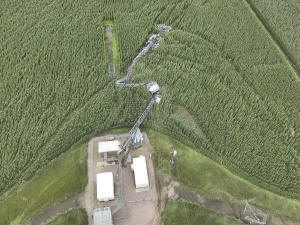|
The weather service's Storm Prediction Center said Tuesday it
made the determination based on local storm reports showing
straight-line winds gusting well over 60 mph (97 kph) from South
Dakota and into Iowa, Minnesota and western areas of Illinois
and Wisconsin from late Monday into early Tuesday. A storm is
classified as a derecho if its wind damage swath extends more
than 240 miles (386 kilometers) and has wind gusts of at least
58 mph (93 kph) or greater along most of the length of the
storm’s path.
Many areas reported gusts of over 75 mph (121 kph). The highest
reading appeared to be in northwestern Iowa just before 10 p.m.
Monday, when a gust clocked at 99 mph (159 kph) was recorded at
Sioux Center.
The high winds tore down trees and tree limbs throughout the
region, damaged some buildings and left thousands of customers
without power by midday Tuesday. But the overnight derecho was
not nearly as destructive as others in recent history, like one
in 2020 that traveled from eastern Nebraska across Iowa and into
Wisconsin and Illinois, reaching wind speeds of a major
hurricane and flattening an estimated 100,000 trees in and
around Cedar Rapids, Iowa.
A December 2021 derecho in the Great Plains and Upper Midwest
spawned at least 45 tornadoes, caused widespread damage and
killed at least five people.
The overnight storms didn't drop as much rain as was feared,
meteorologists said.
“It looks like everything certainly stayed under 2 inches," or 5
centimeters, said Alexis Jimenez, a National Weather Service
meteorologist in Des Moines, Iowa.
That could change, at least for Iowa, Tuesday night into
Wednesday, Jimenez said.
“It’s southwest Iowa’s turn for thunderstorms with heavy rain,”
Jimenez said. “We're looking at maybe some more damaging winds.
Of course, none of the magnitude as we saw last night.”
The weather service said severe thunderstorms are expected
Tuesday into Wednesday from southern Montana into the central
High Plains and across much of Nebraska and Iowa.
All contents © copyright 2025 Associated Press. All rights
reserved |
|




